

Performance monitoring in CSS animations - Chegg - Medium. Animation using JavaScript ?
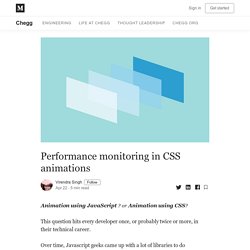
Or Animation using CSS? This question hits every developer once, or probably twice or more, in their technical career. Over time, Javascript geeks came up with a lot of libraries to do animation in the browser, and everyone seems convinced to use these libraries as the off-the-shelf solution. But, hang on, is this the right solution? Should we do animation using JavaScript? Since you’re reading this blog, I’ll assume that you are familiar with JavaScript animations. The foundation of animation relies on some CSS properties that you will often use in CSS based animation heavy implementations. position: (absolute /relative)transformopacityleft, right, top, bottom and many more. Let’s begin by looking at the results from two experiments with different CSS properties for animation. (a) position absolute with left and top (b) transform. Increase the speed of your mobile site with this toolkit. The Importance Of Page Size And How It Affects Your Seo.
Table of contents Definition The term page size in the SEO world refers to the downloaded file size of a given web page.
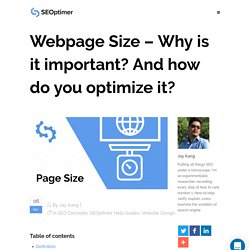
The page size is made up of all the files that make up the page. A typical web page is made up of several files that may include HTML, CSS, Javascript, or image files, as well as other resources. How does page size work? All these files have different sizes that, when added up, equal the page size. When you review your site with SEOptimer, you can easily identify the total page size of your website with the most contribution. Web page sizes have been growing steadily over the years. According to Pingdom’s Average Webpage in 2017 report, an average 819 KB was dedicated to video and 1,818 KB for images.
Google recommends 500 KB given that 1.49 MB takes seven seconds to load using a fast 3G connection. Charger efficacement du JavaScript tiers. If a third-party script is slowing down your page load, you have two options to improve performance: Remove it if it doesn't add clear value to your site.Optimize the loading process.
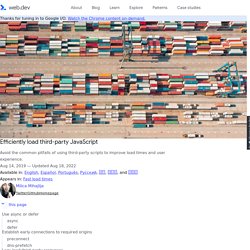
This post explains how to optimize the loading process of third-party scripts with the following techniques: Using the async or defer attribute on <script> tagsEstablishing early connections to required originsLazy-loadingOptimizing how you serve third-party scripts Use async or defer # Because synchronous scripts delay DOM construction and rendering, you should always load third-party scripts asynchronously unless the script has to run before the page can be rendered.
Efficiently load third-party JavaScript. Tools for Web Developers Using a <link> tag is a common way to add styles to a page: The main.css file that the browser downloads is known as an external stylesheet, because it's stored separately from the HTML that uses it.
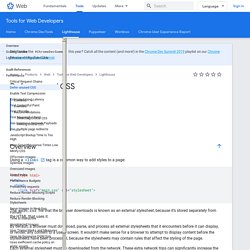
By default, a browser must download, parse, and process all external stylesheets that it encounters before it can display, or render, any content to a user's screen. It wouldn't make sense for a browser to attempt to display content before the stylesheets have been processed, because the stylesheets may contain rules that affect the styling of the page. Each external stylesheet must be downloaded from the network. These extra network trips can significantly increase the time that users must wait before they see any content on their screens.
Unused CSS also slows down a browser's construction of the render tree.
Lighthouse. Web Fonts. Web performance testing: Top 12 free and open source tools to consider. The performance of your web application affects your business more than you might think.

Top engineering organizations consider performance not as nice-to-have, but as a crucial feature of their products. Unfortunately, most engineering teams do not regularly test the performance and scalability of their infrastructure, and most lack the tools to properly do so. Although you can find plenty of commercial tool options out there, for the right organization, free and open source tools may be a good alternative—or the perfect complement to your commercial tool set. [ Learn how to apply DevOps principles to succeed with your SAP modernization in TechBeacon's new guide.
Plus: Get the SAP HANA migration white paper. ] The value of performance Before talking tools, let’s consider load times and the value of performance. How fast is fast enough for a web application? Engineering teams should treat performance as a feature. [ Is it time to rethink your release management strategy? Locust.io Locust.io.
FMP: First Meaningful Paint. Coined by Google, First Meaningful Paint is the time it takes for a page's primary content to appear on the screen.
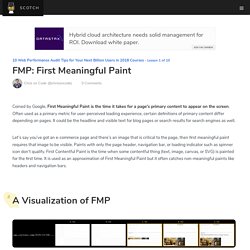
Often used as a primary metric for user-perceived loading experience, certain definitions of primary content differ depending on pages. It could be the headline and visible text for blog pages or search results for search engines as well. Let’s say you’ve got an e-commerce page and there’s an image that is critical to the page, then first meaningful paint requires that image to be visible. Paints with only the page header, navigation bar, or loading indicator such as spinner icon don't qualify. First Contentful Paint is the time when some contentful thing (text, image, canvas, or SVG) is painted for the first time. A Visualization of FMP. PageSpeed Insights. Lazysizes - the ultimate lazyloader for responsive images, iframes and widget.